Castell de Requesens (Cantallops)
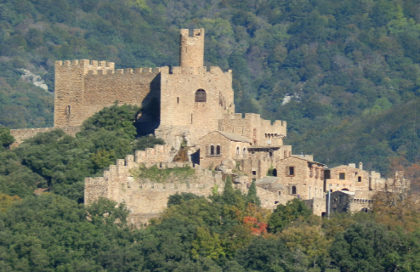 The Castell de Requesens is an oddly remote, yet wonderful semi-preserved castle set in the hills of the Albera mountains that separate Spain and France just to the east of La Jonquera.
The Castell de Requesens is an oddly remote, yet wonderful semi-preserved castle set in the hills of the Albera mountains that separate Spain and France just to the east of La Jonquera.
When I say 'oddly remote' it's because the castle itself is approximately 6km from the nearest village of Cantallops, along a dusty gravel track that wends its way through the hills and with no obvious routes or lands that such a strong castle would need to defend.
We had seen pictures and we knew of the castle because it had cropped up in some deep history of the Catalan counties, and their warring counts, so on a clear day we headed towards the French border and La Jonquera, before turning out of the large cut-price supermarkets that cater to the departing French, and up to the small village of Cantallops.
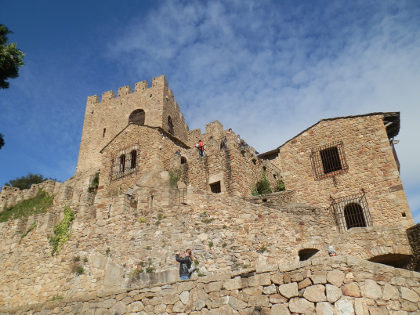 Our aim had been to walk from Cantallops up as there should be a circular walk to the castle and then back down. However, though Baix Emporda was clear as a bell, as our drive crossed into Alt Emporda the wind was blowing fiercely from the direction of the newly snowcovered Pyrenees.
Our aim had been to walk from Cantallops up as there should be a circular walk to the castle and then back down. However, though Baix Emporda was clear as a bell, as our drive crossed into Alt Emporda the wind was blowing fiercely from the direction of the newly snowcovered Pyrenees.
By the time we got to Cantallops there was a fierce crosswind channelling along the hills. Not wanting to waste the journey we decided to attempt to drive up, at least to see what the castle was like.
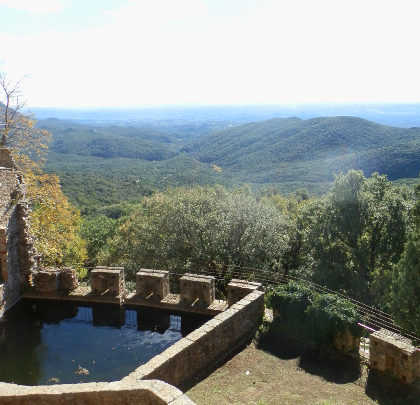 What we hadn't quite anticipated was the gravel track we'd need to take just after the exit of the village.
What we hadn't quite anticipated was the gravel track we'd need to take just after the exit of the village.
I'm not keen on untarmacked roads, particularly after having got stuck on Montgri a few years ago, and this was a typical one of those roads, pitted and potholed, narrowing at times and occasionally with an open drop to the side.
We didn't know it when we started, but it actually gets better further up. Our suspension got a work out as we made our way up, but we weren't the only ones on the route. This is a popular place to visit as we found when we got to the top.
The other part was that luckily we didn't meet anyone going up as we were early enough so all the traffic was in one direction.
This is a one way in and out road, so later in the day you would find vehicles coming from the other direction too.
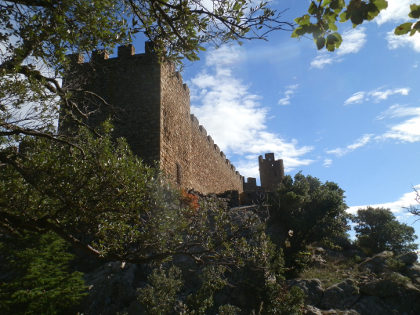 The road climbs for a 3-4 kilometres and then reaches a gate. The gate marks the start of the Requesens estate - a large area of hilly woodland. Just outside the gate a number of cars had parked up in the limited space available, but as we discovered, it was fine to go through the gate and to drive all the way to the top for either the castle or for the restaurant set just outside the castle.
The road climbs for a 3-4 kilometres and then reaches a gate. The gate marks the start of the Requesens estate - a large area of hilly woodland. Just outside the gate a number of cars had parked up in the limited space available, but as we discovered, it was fine to go through the gate and to drive all the way to the top for either the castle or for the restaurant set just outside the castle.
We weren't sure if you really were permitted to drive on past the gate, and having the original plan of walking, it didn't seem too much of a hardship to walk the remaining couple of kilometres, so we parked up and walked, particularly since we were in the lee of the hills and so protected from the wind that we had seen further down.
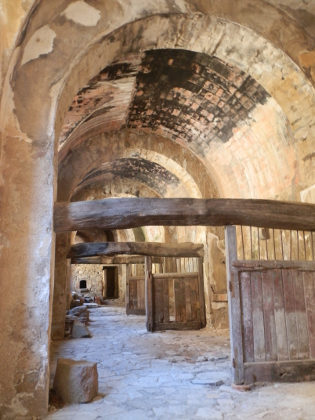 Our walk followed the gravel track, and we were passed by a regular drip of cars bumping along the track.
Our walk followed the gravel track, and we were passed by a regular drip of cars bumping along the track.
After the first corner we suddenly got the first glimpse of the castle standing on a hill surrounded by the hills. From a distance it looks like a very well-preserved large chateau-fort to use a French description of a traditional fortified castle, rather than one that is merely pretty.
As the track gets closer, there are signs of other buildings and a little bit more habitation - a monastery or convent in the mountain behind the castle, and old sawmills, and small fields nestle along a small stream at the bottom of the castle, with 10-20 of cars parked either for the castle or for the restaurant. All of which is quite a surprise for the apparent remoteness of the location.
The stream itself was another surprise - with water rushing down and a few small cascades through the rocks. For the height (the castle is at about 500m) and the comparative dryness of the area we wouldn't have expected to have such as strong water flow.
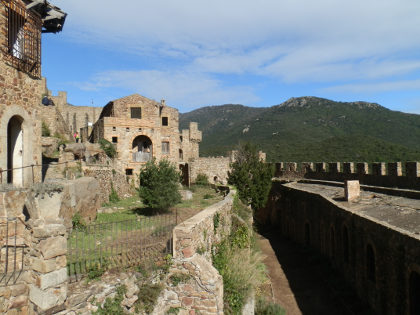 The track crosses the stream and then heads up to the castle itself. As we approached the main entrance we had to pass a herd of cows scavaging what grass they could in amongst the woods - another oddity.
The track crosses the stream and then heads up to the castle itself. As we approached the main entrance we had to pass a herd of cows scavaging what grass they could in amongst the woods - another oddity.
The castle itself has large outer walls in good repair. It was renovated or rebuilt at the end of the 19th century as a summer residence for the Counts of Peralada (the Rocaberti) before being converted into military barracks mid 20th Century. Though it is empty now and shows signs of deriliction, it is by no means a ruin.
From the gatehouse at the bottom the first impression is something of a wedding cake of buildings layered on top of each other. Each layer is linked with stairs and walk ways up to the upper tower at the top (the tower itself isn't accessible).
Much of the castle rooms are open and can be explored with the remains of kitchens and storerooms as well as living quarters with enormous views out across the Empordan plain towards the sea and the Mountains of Montgri to the south.
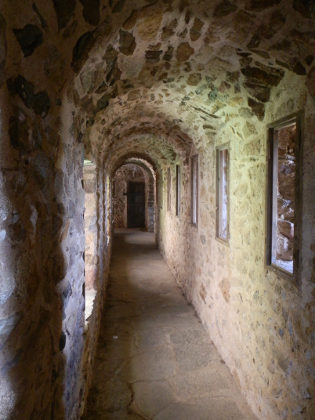 And there's another surprise as water seems to flow down and through the castle - as if it's been built on an active spring, with water flowing down small channels on the walls and into holding ponds built beside the castle walls.
And there's another surprise as water seems to flow down and through the castle - as if it's been built on an active spring, with water flowing down small channels on the walls and into holding ponds built beside the castle walls.
The cost to enter the castle is €4 per person, but it has the impression of an Enid Blyton type of castle of adventure, full of nooks and crannies and strange passageways linking rooms and courtyards in among the buildings.
The rooms themselves feel a little abandoned and times, and there are signs of the time of military occupation with a hospital's red cross above one door. However some of the interior parts are clearly still being renovated and the castle has a certain joie-de-vivre.
And we weren't the only visitors, with several families and younger children coming to explore, or taking the day out for the castle and Saturday lunch.
The walk back was a little bit one way, though we did follow the stream a little more rather than the road through the narrow meadows by the ruins of the sawmill. And we were passed by cars going down from this strangely remote yet well-visited castle.
Nearby: Lladó (between Figueres and Besalu) - Figueres and Castell de Sant Ferran - Waterfall at Les Escaules (Boadella) - Espolla to Rabos - La Jonquera to Fort de Bellegarde (France) - Sant Llorenç de la Muga - Sant Pere de Rodes - Llança - Portbou to Cerbère (France)

 Walks and other things
Walks and other things